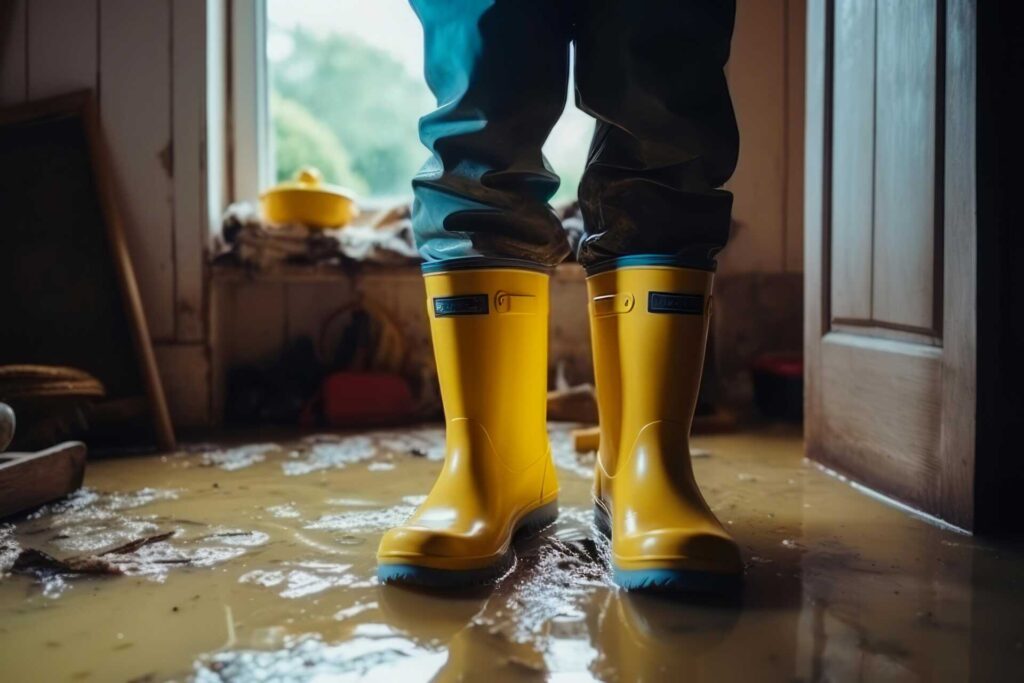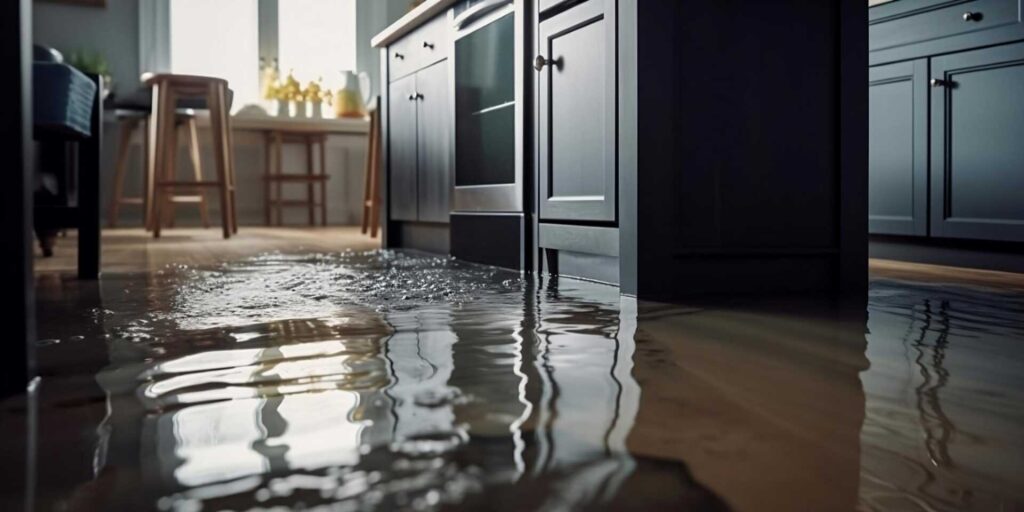Contents
You might not realize how a small leak can turn into a significant issue for your commercial building. The implications of water damage extend far beyond visible signs of wetness. Understanding the hidden risks associated with water intrusion is crucial for protecting your business assets and maintaining a safe environment for occupants. By taking proactive measures to mitigate water damage, you can prevent a cascade of consequences that may impact your bottom line and reputation.
Key Takeaways
- Prevents structural damage and costly repairs.
- Minimizes health risks from mold growth.
- Reduces business disruptions and financial losses.
- Maintains a positive reputation and customer trust.
- Helps manage insurance premiums and budgets effectively.
Costly Property Damage
When water infiltrates commercial buildings, it can lead to costly property damage that requires immediate attention. Water damage can wreak havoc on a building’s structure and interior, causing destruction to walls, ceilings, flooring, and valuable assets within the premises. To prevent mold growth and protect assets, swift action is crucial.
Mold growth is a common consequence of water damage and can lead to health hazards as well as additional costly repairs. Mold thrives in moist environments, making properties affected by water damage highly susceptible to its growth. By promptly addressing water infiltration, you can effectively prevent mold from taking hold and spreading throughout the building.
In addition to preventing mold growth, swift water damage mitigation is essential for protecting assets within the commercial building. Assets such as equipment, inventory, and furniture can suffer irreparable damage if exposed to water for extended periods. This can result in financial losses for the business and disrupt its operations. By addressing water damage promptly, you can safeguard these assets and minimize the impact on the business.
Health and Safety Risks
Water damage in commercial buildings not only leads to costly property damage but also poses significant health and safety risks that must be addressed promptly. When water infiltrates a building, it creates a conducive environment for mold growth. Mold thrives in damp conditions and can start developing within 24-48 hours after water exposure. This can lead to respiratory issues, allergic reactions, and other health concerns for occupants. Additionally, prolonged exposure to mold spores can severely impact indoor air quality, which is a crucial factor in maintaining a healthy workspace for employees and visitors.
To highlight the impact of mold growth on indoor air quality, consider the following table:
| Health and Safety Risks | Description |
|---|---|
| Mold Growth | Flourishes in damp environments, causing respiratory issues and allergic reactions. |
| Indoor Air Quality | Impacted by mold spores, leading to poor air quality and potential health concerns. |
It is essential to address water damage promptly to prevent mold growth and maintain optimal indoor air quality. Failure to mitigate water damage effectively can result in long-term health risks and safety hazards for everyone within the commercial building.
Structural Integrity Compromised
Structural integrity in commercial buildings can be compromised when prolonged exposure to moisture or water damage weakens foundational components. When water infiltrates a building, it can seep into walls, floors, and ceilings, causing wood to rot, metal to corrode, and concrete to weaken. This deterioration can lead to a range of issues, from sagging ceilings and warped floors to cracks in walls and compromised support beams.
If left unaddressed, the structural damage caused by water infiltration can have significant consequences for building safety. Weakened foundations and compromised support structures pose a risk to occupants and can result in catastrophic structural failures. Ensuring the structural integrity of a commercial building is essential for safeguarding the well-being of those who live or work within its walls.
In addition to the potential safety hazards posed by compromised structural integrity, the repair costs associated with water damage can quickly escalate. Repairing or replacing damaged structural elements can be a costly endeavor, especially if the damage has been allowed to progress unchecked.
Business Disruption and Downtime
You need to consider the operational impact and financial losses associated with business disruption and downtime caused by water damage in commercial buildings.
When your operations are halted due to water damage, it can lead to significant financial repercussions, including lost revenue and increased expenses for repairs.
Understanding the potential business disruptions and downtime is crucial to implementing effective water damage mitigation strategies to minimize these negative impacts.
Operational Impact
Minimize the impact of business disruption and downtime by implementing proactive measures to address potential water damage risks in commercial buildings. Water damage can significantly impede the operational efficiency of a business, leading to reduced productivity and increased expenses.
Here are four key ways in which water damage can affect the operational aspects of commercial buildings:
Business Interruption: Water damage can force temporary closure of your business, halting operations and causing a loss of revenue.
Equipment Damage: Water infiltration can damage machinery, computers, and other crucial equipment, leading to costly repairs or replacements.
Data Loss: Water damage can destroy important digital data stored on servers or computers, resulting in data loss and potential setbacks in business operations.
Health and Safety Concerns: Water damage can create a hazardous environment with mold growth and contaminated water, posing health risks to employees and visitors.
Financial Losses
Addressing financial losses due to business disruption and downtime resulting from water damage requires a systematic approach to mitigate potential risks and ensure operational continuity in commercial buildings.
Business continuity is crucial to minimize the financial impacts caused by water damage incidents. When water damage disrupts operations, it can lead to significant revenue loss due to downtime.
Implementing effective risk management strategies such as having a comprehensive emergency response plan in place can help reduce the financial repercussions of water-related disruptions.
By swiftly addressing water damage issues and restoring normal business operations promptly, the financial losses associated with business interruption can be minimized.
Downtime resulting from water damage can also impact customer satisfaction and loyalty, potentially leading to long-term revenue implications. Therefore, investing in proactive measures to prevent water damage and having a well-prepared response plan is essential for safeguarding the financial stability of commercial establishments.
Potential Legal Liabilities
Mitigating potential legal liabilities related to water damage in commercial buildings requires a comprehensive understanding of building codes and regulations. Failing to address water damage promptly can result in significant legal ramifications and liability concerns for commercial property owners.
Here are some key aspects to consider:
Compliance with Building Codes: Ensuring that your commercial building meets all relevant building codes regarding water damage prevention is crucial. Failure to comply with these codes can lead to legal penalties and potential lawsuits.
Insurance Coverage: Reviewing your insurance policy to understand the extent of coverage for water damage is essential. Inadequate insurance coverage may expose you to legal liabilities in case of water-related incidents.
Contractual Obligations: Evaluating contractual agreements with tenants or contractors regarding water damage responsibilities is vital. Clarity in these agreements can help mitigate legal disputes and liabilities in the event of water damage.
Documentation and Record-Keeping: Maintaining detailed records of inspections, repairs, and preventive measures taken to address water damage is important. In the case of legal disputes, having thorough documentation can provide evidence of due diligence and potentially reduce liability.
Reputation and Customer Trust
Maintaining a positive reputation and earning the trust of customers is paramount for commercial building owners in the context of water damage prevention and management. Your brand image is intricately linked to how well you handle water damage incidents. Customers associate a well-maintained, secure building with a reliable and professional business. On the other hand, repeated water damage issues can tarnish your brand image, leading to a loss of trust and credibility among clients.
Client retention is directly impacted by your ability to effectively mitigate water damage. When customers see that you’re proactive in preventing water-related issues and swift in resolving any that occur, they’re more likely to continue doing business with you.
On the contrary, if water damage incidents become recurrent due to negligence or ineffective management, clients may seek services elsewhere, resulting in a loss of revenue and market share.
Insurance Premium Increases
When considering how water damage can impact commercial buildings, it’s crucial to address the potential consequences of insurance premium increases.
Such increases can significantly strain budgets and financial plans, affecting the overall operational costs of a business.
Understanding the impacts of water damage on insurance premiums is essential for making informed decisions on risk mitigation strategies.
Costly Insurance Consequences
Insurance premium increases for commercial buildings due to water damage incidents can have significant financial implications for property owners. Implementing preventive measures and effective risk management strategies is crucial to mitigate such consequences:
Claims History:
Insurance companies consider the frequency and severity of past water damage claims when determining premiums. A history of water-related incidents can lead to substantial premium hikes.Building Age and Condition:
Older buildings or those with outdated plumbing systems are at a higher risk of water damage. Insurers may increase premiums for properties with these characteristics.Location Factors:
Properties in flood-prone areas or regions with high precipitation levels are more susceptible to water damage. Insurers may adjust premiums based on the property’s geographic location.Loss Ratios:
Insurance carriers analyze loss ratios, which compare the total claims paid to the premiums received. High loss ratios from water damage claims can result in increased premiums for commercial buildings.
Impact on Budgets
Considering the increased insurance premiums resulting from water damage incidents, property owners must closely evaluate the impact on their budgets to effectively manage financial implications. These budget implications can significantly affect the overall financial health of a commercial building. To illustrate the potential impact, let’s look at a comparison between insurance premiums before and after a water damage incident:
As shown in the table above, a water damage incident can lead to an increase in insurance premiums. This substantial rise in costs can strain the budget of property owners. To mitigate such budget implications, implementing cost-effective solutions is crucial. Investing in preventive measures such as regular maintenance, installing leak detection systems, and quick response protocols can help reduce the risk of water damage incidents, thereby potentially lowering insurance premiums in the long run. By carefully managing these budget implications and prioritizing cost-effective solutions, property owners can safeguard their financial stability and protect their commercial buildings from the detrimental effects of water damage.
Review
Mitigating water damage is crucial for commercial buildings due to the costly property damage, health risks, structural integrity concerns, business disruption, legal liabilities, and reputation implications.
By taking proactive measures to prevent water damage, you can avoid potential financial losses, maintain customer trust, and ensure business continuity.
Remember, staying ahead of water damage issues not only protects your assets but also saves you time and money in the long run.




